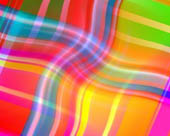
Purpose
To discover how secondary colors are derived from primary colors
Additional information
There are seven colors defining wavelengths of visible light. These colors are red, yellow, green, blue, orange, indigo and violet. This "visible light" corresponds to a wavelength range of 400 - 700 nanometers (nm). From shortest to longest wavelength, the visible colors are ordered as follows: violet, blue, green, yellow, orange, and red.
Additive Color Models
There are three primary colors for additive colorizations. These are red, green, and blue and are often referred to as RGB in the digital world. All computer images use a combination of these three primary colors. When added together, these component colors form the color white.
Subtractive Color Models
The primary colors for subtractive coloration, as in art, are cyan, yellow, and magenta. When combined these colors form the color black.
In this experiment we'll create an array of secondary colors that are derived from primary colors red, yellow, and blue using sheets of cellophane (a thin, transparent sheet made of regenerated cellulose).
Sponsored Links
Required materials
- Flashlight
- Red cellophane
- Blue cellophane
- Yellow cellophane
- Tape
- Pen
- Journal or notebook (to record results)
Estimated Experiment Time
As little as 5 minutes or as long as your creativity will allow.
Step-By-Step Procedure
- 1. Find an area in your house where there is a white wall. The wall needs to be solid white, not off-white or colored.
- 2. Cover the top of the flashlight with a sheet of red cellophane. Now cover the red cellophane with a sheet of yellow cellophane. Shine the flashlight on the wall. What color do you see? Record the results in your journal.
- 3. Remove the yellow cellophane sheet from the previous step.
- 4. Now cover the sheet of red cellophane with a sheet of blue cellophane. Shine the flashlight on the wall. What color do you see? Record the results in your journal.
- 5. Remove both the blue AND red cellophane sheets from the previous step. You should now have an uncovered flashlight.
- 6. Cover the top of the flashlight with a sheet of blue cellophane. Now cover the blue cellophane with a sheet of yellow cellophane. Shine the flashlight on the wall. What color do you see? Record the results in your journal.
- 7. What other colors can you make with the flashlight and the cellophane? Try different combinations and find out!
Note
If your cellophane is not self-adhesive, you'll need to use tape to get the cellophane to attach over the top of the flashlight.
Observation
What colors did you create with the flashlight and cellophane? Did you expand the experiment and try to make your own secondary colors? Do you think you can make black with the cellophane sheets? Give it a try and find out!
Result
Primary colors for subtractive colorization in art are made up of red, blue, and yellow. When combinations of these colors are put together, they form secondary colors such as green, orange, or purple. When you place the cellophane combinations on the flashlight and shine it on the wall, you're creating secondary colors!
Sponsored Links
Take a moment to visit our table of Periodic Elements page where you can get an in-depth view of all the elements,
complete with the industry first side-by-side element comparisons!